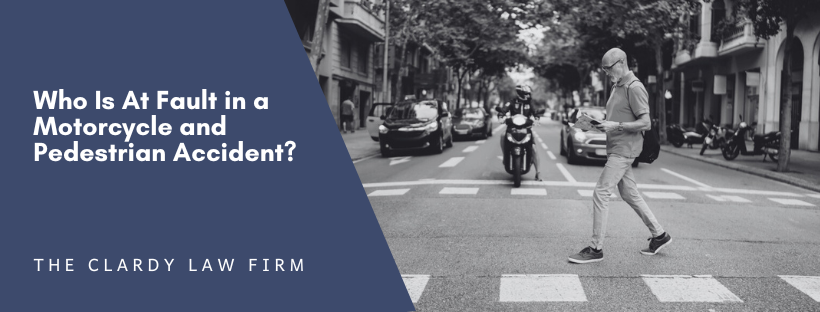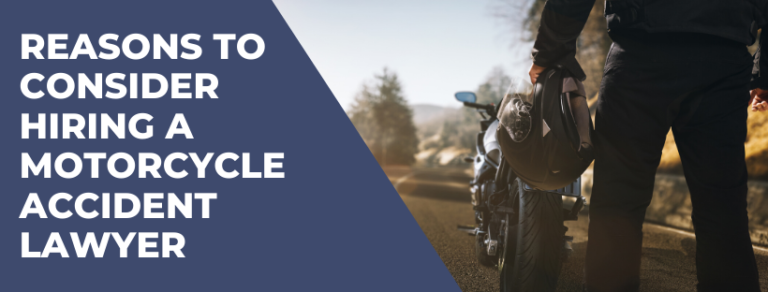Motorcycle and pedestrian accidents present complex legal challenges, often leaving those involved with significant injuries and unanswered questions about liability. Determining who is at fault in such incidents requires a thorough understanding of traffic laws, the circumstances of the accident, and the behaviors of both parties involved.
As a personal injury lawyer, it is crucial to analyze each case meticulously to establish fault and seek justice for the injured party.
Understanding Liability in Motorcycle and Pedestrian Accidents
The Basics of Fault Determination
Fault in motorcycle and pedestrian accidents is determined based on the principles of negligence. Negligence occurs when an individual fails to exercise reasonable care, resulting in harm to another person. To establish negligence, four elements must be proven:
- Duty of care: The defendant owed a duty of care to the plaintiff.
- Breach of duty: The defendant breached that duty of care.
- Causation: The breach caused the plaintiff’s injuries.
- Damages: The plaintiff suffered actual damages (physical, emotional, financial) as a result.
Common Causes of Motorcycle and Pedestrian Accidents
Accidents involving motorcycles and pedestrians can happen due to various reasons, including:
- Distracted Driving: Motorcyclists not paying attention to the road, often due to mobile phone use, can fail to see pedestrians.
- Speeding: High speeds reduce reaction times and increase the severity of collisions.
- Impaired Driving: Alcohol or drug impairment can lead to reckless behavior and accidents.
- Pedestrian error: Pedestrians crossing roads improperly or unexpectedly entering traffic can cause accidents.
- Poor visibility: Weather conditions, low light, or blind spots can obscure the view of both motorcyclists and pedestrians.
Legal Obligations of Motorcyclists and Pedestrians in South Carolina
Both motorcyclists and pedestrians have legal responsibilities to ensure their own and others’ safety. Understanding these obligations is critical in determining fault.
Motorcyclists’ Responsibilities
- Obey traffic laws: Motorcyclists must adhere to all traffic signals, speed limits, and road signs.
- Yield to pedestrians: When crossing at marked crosswalks or intersections, motorcyclists must yield to pedestrians.
- Drive sober: Operating a motorcycle under the influence of alcohol or drugs is illegal and highly dangerous.
- Avoid distractions: Staying focused on the road and avoiding distractions like mobile phones is essential.
- Wear a helmet: Riders under the age of 21 are required to wear helmets. Helmets must be approved by the Department of Public Safety and meet specific safety standards. Passengers under the age of 21 must also wear helmets.
- Remain in a single lane: Lane splitting (riding between lanes of traffic) is illegal in South Carolina.
- Have working lights: Motorcycles must have a working headlight, tail light, and brake light. Headlights must be used at all times, day and night.
- Hold a valid motorcycle license: Motorcyclists must have a valid motorcycle endorsement on their driver’s license.
Additional laws can be read in the SCDPS’ South Carolina Motorcycle Laws article 29.
Pedestrians’ Responsibilities
- Use crosswalks: Pedestrians should cross streets at designated crosswalks and follow pedestrian signals.
- Yield to vehicles: Pedestrians must yield to vehicles when crossing streets at points without marked crosswalks or signals.
- Stay alert: Avoiding distractions, such as texting while walking, ensures pedestrians are aware of their surroundings.
- Obey traffic signals: Pedestrians must adhere to “walk” and “don’t walk” signals at intersections.
- Avoid impairment: Just as with drivers, pedestrians impaired by alcohol or drugs may not act safely.
- Walk on the left: When sidewalks are not available, pedestrians should walk on the left side of the roadway facing traffic.
Determining Fault in Specific Scenarios
The phrase “pedestrians have the right of way” isn’t always accurate. This doesn’t give pedestrians the right to be ignorant. They share equal responsibility for helping to ensure that roads are safe. In the scenario where a pedestrian is crossing traffic against safety signals or is walking in restricted areas, they can be deemed negligent. As a result of this, they can also be held responsible for an accident.
Scenario 1: Motorcyclist Failing to Yield
If a motorcyclist fails to yield to a pedestrian at a marked crosswalk and an accident occurs, the motorcyclist is likely to be found at fault. Traffic laws clearly state that vehicles must yield the right-of-way to pedestrians at crosswalks. In this scenario, the motorcyclist breached their duty of care by not yielding, leading to the pedestrian’s injuries.
Scenario 2: Pedestrian Jaywalking
Conversely, if a pedestrian jaywalks (crosses the street outside of a designated crosswalk) and is struck by a motorcyclist, the pedestrian may be found at fault. Jaywalking is illegal and puts pedestrians at risk, as drivers, including motorcyclists, are not expecting someone to cross at that point. The pedestrian’s action of crossing the road unsafely constitutes a breach of their duty of care.
Scenario 3: Shared Fault
In some cases, both the motorcyclist and the pedestrian may share fault. For instance, if a pedestrian crosses at a crosswalk but does not look for oncoming traffic, and a motorcyclist is speeding, both parties may be considered negligent. The motorcyclist for speeding and the pedestrian for not ensuring the road was clear before crossing. In such cases, comparative negligence rules may apply, where the fault is apportioned between both parties.
Scenario 4: Poor Visibility Conditions
Accidents occurring under poor visibility conditions, such as fog or heavy rain, add another layer of complexity. If a motorcyclist hits a pedestrian in these conditions, the determination of fault will consider whether the motorcyclist was driving appropriately for the weather conditions. Similarly, if the pedestrian did not take precautions, such as wearing visible clothing or using a flashlight, their negligence may be considered.
Investigating the Accident
Gathering Evidence
A thorough investigation is critical in determining fault in motorcycle and pedestrian accidents. Key steps include:
- Collecting witness statements: Eyewitnesses can provide valuable insights into how the accident occurred.
- Reviewing surveillance footage: Nearby cameras may have captured the incident, offering visual evidence.
- Examining police reports: Law enforcement documentation can provide an unbiased account of the accident and initial determinations of fault.
- Accident reconstruction: Experts can recreate the accident scenario to better understand the dynamics involved.
Analyzing Evidence
Evidence must be meticulously analyzed to build a strong case. This involves:
- Assessing damage: Examining the extent and nature of damage to both the motorcycle and the pedestrian.
- Evaluating medical reports: Understanding the injuries sustained and how they correlate with the accident details.
- Comparing statements: Cross-referencing witness statements with physical evidence to identify inconsistencies or corroborations.
Legal Considerations and Comparative Negligence
Pure Comparative Negligence
In states that follow pure comparative negligence laws, each party can recover damages proportionate to their degree of fault. For example, if a pedestrian is found to be 30% at fault and the motorcyclist 70%, the pedestrian can still recover 70% of the total damages awarded.
Modified Comparative Negligence
Some states follow modified comparative negligence rules, which bar recovery if a party is found to be more than 50% at fault. In these states, if a pedestrian is 51% responsible for the accident, they would not be able to recover any damages.
Contributory Negligence
A few states adhere to contributory negligence laws, where any fault on the part of the plaintiff completely bars recovery. Thus, if a pedestrian is found to be even 1% at fault, they would be unable to recover damages from the motorcyclist.
The Role of Insurance Companies
Filing Claims
Both motorcyclists and pedestrians may need to file claims with insurance companies following an accident. Motorcyclists typically have liability insurance that may cover injuries to pedestrians. Pedestrians may also have personal injury protection (PIP) coverage under their health insurance policies.
Insurance Adjusters
Insurance adjusters will investigate the claim to determine the extent of liability and damages. They will evaluate medical records, witness statements, and other evidence. It is crucial to be cautious when dealing with insurance adjusters, as their goal is often to minimize the payout.
Settlements
Insurance companies may offer settlements to resolve claims quickly. It is important to consult with a motorcycle injury lawyer before accepting any settlement offers to ensure that the compensation is fair and covers all damages, including medical expenses, lost wages, and pain and suffering.
Seeking Legal Assistance
Why Hire a Personal Injury Lawyer?
Navigating the complexities of fault determination and insurance claims can be challenging. A motorcycle injury lawyer can:
- Provide legal knowledge: Understand the nuances of traffic laws and negligence principles.
- Conduct thorough investigations: Gather and analyze evidence to build a strong case.
- Negotiate with insurance companies: Ensure fair compensation for the injured party.
- Represent in court: Advocate for the injured party’s rights if a fair settlement cannot be reached.
Steps to Take After an Accident
- Seek medical attention: Prioritize health and get immediate medical care for any injuries.
- Report the accident: File a police report to document the incident.
- Gather information: Collect contact information from witnesses and take photographs of the accident scene.
- Consult a lawyer: Seek legal advice from a motorcycle injury lawyer to understand your rights and options.
Determining who is at fault in a motorcycle and pedestrian accident requires a careful analysis of the actions of both parties involved. Understanding traffic laws, gathering and analyzing evidence, and navigating insurance claims are crucial steps in seeking justice and compensation. By adhering to their respective legal responsibilities, both motorcyclists and pedestrians can contribute to safer roadways and reduce the risk of such accidents.




